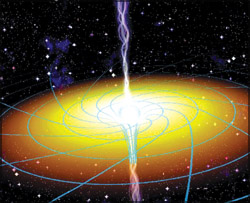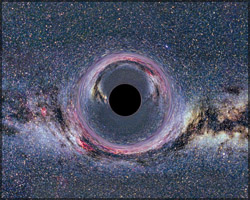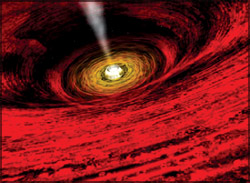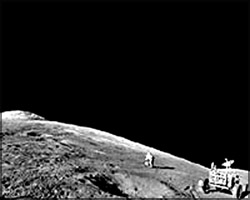Mystery of black holes
 Most
of you who watch science fiction movies and cartoons on space may be
familiar with the word 'black holes'; the very mention of it makes some
of us shudder in fear because black holes are a mysterious part of
space, often portrayed as sinister, 'dangerous' places in movies. But,
black holes are not just science fiction; they do exist and astronomers
are yet to unravel their mysteries. Most
of you who watch science fiction movies and cartoons on space may be
familiar with the word 'black holes'; the very mention of it makes some
of us shudder in fear because black holes are a mysterious part of
space, often portrayed as sinister, 'dangerous' places in movies. But,
black holes are not just science fiction; they do exist and astronomers
are yet to unravel their mysteries.
Black holes are an extremely
complicated concept and there are many theories about them... We will
try to give you a brief explanation about them today.
What is a black hole?
A black hole is a tiny area of space with a gravitational pull so
large that it creates a region which becomes cut off from the rest of the Universe. You are all aware of the
gravitational pull of Earth. It can simply keep everything around us
fixed to the ground.
off from the rest of the Universe. You are all aware of the
gravitational pull of Earth. It can simply keep everything around us
fixed to the ground.
It does not affect any other objects in outer space. But, a black
hole is like a demon that swallows up everything around it.
Its gravitational pull is so strong, that even light is drawn towards
it, never to reflect back. I believe this alone is enough for you to
understand the force that a black hole has.
As you know, light should reflect from an object and reach our eyes
for us to see it. But, a black hole does not let light reflect.
Therefore, it remains black in colour, and this has given rise to the
name.
A black hole is created when a star dies.
As the star dies, the nuclear fusion(joining together) reactions stop
because the fuel for these reactions gets burned up. At the same time,
the star's gravity pulls material inward and compresses the core.
Then, it heats up and eventually creates a supernova explosion in
which the material and radiation blasts out into space. A highly
compressed(squeezed up) and massive core is what will be left. The
core's gravity is so strong that even light cannot escape.
What happens if something falls in to
a black hole?
  Once
something is attracted to a black hole, there will be huge forces on it,
acting towards dragging it to the black hole. Once
something is attracted to a black hole, there will be huge forces on it,
acting towards dragging it to the black hole.
The parts of the object closer to the black hole will be experiencing
very large forces compared to the other parts. This can result in the
object being deformed, and this is called spaghettification which you
could picture as the object being stretched like spaghetti.
Once it approaches the centre of the black hole, the forces on it
become extremely strong, that atoms, and even sub-atomic particles get
torn apart. However, as soon as an object passes the hole's boundary of
the region from which not even light can escape, which is known as the
event horizon, it is lost to the outside world.
Kinds of black holes
* Supermassive black holes. These are really biggies in the Universe.
Believe it or not, these can have masses which can be immense as
millions or billions of times the mass of the Sun. These are believed to
be in the middle of galaxies like the Milky Way.
* Intermediate mass black holes. These black holes have masses which
can be counted in thousands of times the mass of the Sun.
* Stellar mass black holes. The mass of these can range from about
1.5 times the mass of sun up to around 30 times the mass of the Sun.
* Micro black holes. These are black holes with masses below the mass
of an average star.
A climate monitoring system on the
Moon?
Long ago, the Moon was a great subject for poets to write about. But,
now things have gone further, and the Moon has become a good option to
setup a climate monitoring system for Earth.
Shaopeng Huang, a geophysicist of the University of Michigan has
recently showed in one of his online publications that surface temperatures on the near side of the Moon
accurately records important information about the Earth's climate
system.
publications that surface temperatures on the near side of the Moon
accurately records important information about the Earth's climate
system.
According to him, global climate change is driven by an imbalance
between incoming energy from the Sun and outgoing energy from the Earth
and when it is to be measured, it seems difficult with existing
ground-based and space-borne technologies.
However, instruments left behind by the Apollo 15 astronauts have
provided just the necessary measurements for him. The system which was
supposed to measure the Moon's ground temperature under the Apollo 15
mission has ended up sending the surface temperature of the Moon.
After examining the Moon data set, Shaopeng Huang has realised that
it could provide valuable information on Earth's climate shifts.
Aravinda Dassanayake |
